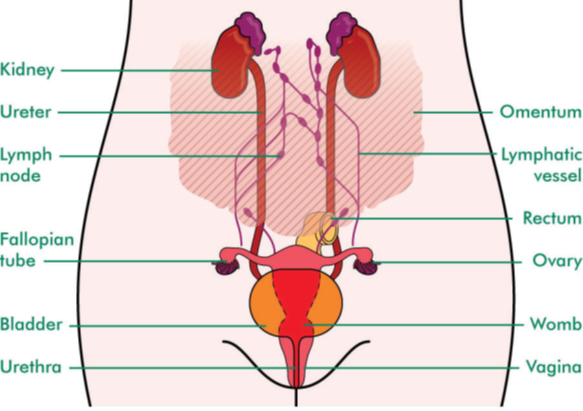Ovarian Cancer
What is Cancer?
The body is made up from millions of cells that are constantly dying and being replaced. Normally, cells divide in an orderly and controlled way. Cancer occurs when a cell divides and multiplies too rapidly. This produces a lump of abnormal cells known as a tumour. Tumours are either benign (non-cancerous) or malignant (cancerous). There are 200 different types of cancer and early detection can greatly increase the chances for successful treatment.
Ovarian cancer affects more than 6,500 women in the UK each year. It is the fifth most common cancer among women after breast cancer, bowel cancer, lung cancer and cancer of the uterus (womb). Ovarian cancer is most common in women who have had the menopause (usually over the age of 50), but it can affect women of any age.
Ovarian Cancer
The Ovaries
Approximately 163 females in Northern Ireland are diagnosed with ovarian cancer and over 117 lives are lost each year to the disease. Smear tests do not detect ovarian cancer.
The ovaries are 2 small, oval-shaped organs, one on each side of the body and are part of the female reproductive system. They are in the lower part of the abdomen, which is known as the pelvis.
Other organs very close to the ovaries (see diagram). These include:
- The ureter, which drains urine from the kidney to the bladder
- The bladder
- The back passage (rectum)
- The omentum – a membrane which surrounds all of the pelvic and abdominal organs and keeps them in place. It is also called the peritoneum.
- A collection of lymph nodes
- The womb
- Kidney
- Fallopian Tube
- Lymphatic vessel
- Ovary
- Vagina

The Ovaries
Types of ovarian cancer
There are several types of ovarian cancer. They include:
- Epithelial ovarian cancer, which affects the surface layers of the ovary and is the most common type
- Germ cell tumours, which originate in the cells that make the eggs
- Stromal tumours, which develop within the cells that hold the ovaries together
Epithelial ovarian cancer is by far the most common type of ovarian cancer.
The exact cause of ovarian cancer is unknown, although a number of possible factors are thought to be involved, such as the number of eggs the ovaries release and whether someone in your family has had ovarian cancer in the past. However, only one in 10 cases of ovarian cancer has a genetic link.
Types of Ovarian Cancer
Symptoms of ovarian cancer
As the symptoms of ovarian cancer can be similar to those of other conditions, it can be difficult to recognise. However, there are early symptoms to look out for, such as-
- Persistent bloating
- Pain in the pelvis and lower stomach
- Unexplained tiredness
Other symptoms include –
- Loss of appetite / feeling full quickly
- Needing to pass urine more often or more urgently
- Back pain
- Changes in Bowel habits
If you have these symptoms for a month or on at least 12 days in a month you should consult your GP.
Symptoms of Ovarian Cancer
Risk factors for ovarian cancer
The cause of ovarian cancer is unknown however there are a number of factors that can increase your risk.
Age
The majority of cases occur in women over the age of 40; however, it is possible to be affected by ovarian cancer from the age of 20 onwards.
Family history
Most ovarian cancers are due to gene changes that develop during a woman’s life and are not inherited. But about 1 in 10 ovarian cancers (10%) are caused by an inherited faulty gene. Faulty inherited genes that increase the risk of ovarian cancer include BRCA1 and BRCA2. These genes also increase the risk of breast cancer.
If you have a mother, sister or daughter who have had ovarian cancer or breast cancer you may be more at risk of developing ovarian cancer than other women in the population. If your relatives were under 50 years old when their cancers were diagnosed, it is more likely that their cancer is due to an inherited faulty gene.
Childbirth
Women who have given birth have a lower risk of ovarian cancer than women who have not.
Risk factors for Ovarian Cancer
Detection
At the moment there is no reliable screening test for detecting ovarian cancer in the general population, however there are clinical trials looking into developing such screening. The following tests may be carried out to check for ovarian cancer when there are concerns:
- Internal examination
- A blood test for CA125 – It’s normal to have some CA125 in the blood, but the level may be higher in women with ovarian cancer
- Transvaginal ultrasound scan – A small device is placed into your vagina. As before the device produces sound waves which are then converted into a picture by a computer
- CT (CAT) Scan – a series of x-rays which build up a three-dimensional picture of inside of the body
- Laparoscopy – a small operation which allows the doctor to look at the ovaries and the surrounding area. It is done under a general anaesthetic, and may mean a short stay in hospital.
- Laparotomy – Sometimes cancer of the ovary cannot be definitely diagnosed before a full operation (laparotomy) is performed

Detection
Action Cancer provides…
Early Detection
Breast screening services and health checks available from the Big Bus and Action Cancer House in Belfast.
Support Services
Complementary therapy, acupuncture, counselling, life coaching, peer mentoring; and our Positive Living Programmes are available for those impacted by cancer in order to enhance quality of life and learn coping strategies.
Education
As a local charity with a focus on cancer awareness, prevention and detection the health promotion team deliver a range of services and programmes to schools, communities and workplaces across Northern Ireland.
